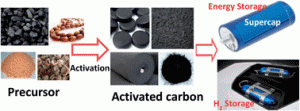In this interesting and informative article, M. Sevilla and R. Mokaya review state-of-the-art synthesis methods for the preparation of activated carbons and their application in energy storage systems. Specifically, the authors detail recent developments in the control of properties such as pore size distribution, surface area and structural and chemical characteristics – and how such properties relate to performance in hydrogen storage and supercapacitors.
Activated carbons have a number of desirable features that make them attractive for use in advanced energy-storage systems. As well as being relatively light-weight, low-cost and chemically inert, they also have very large surface areas (> 1000 m2/g) and high micropore volumes in which to interact with other species. This makes activated carbons particularly useful as supercapacitor electrodes and hydrogen storage materials – where performance is strongly related to surface area and pore characteristics.
In this review, recent developments in the fabrication of activated carbons are discussed, focusing particularly on methods which allow the control of features, such as pore size distribution, surface area and physical and chemical characteristics such as texture, morphology and heteroatom-doping. The relationship between these properties and the performance of these materials as supercapacitor electrodes and their use in hydrogen storage is also looked at in detail, providing a guide for the direction of future research in this very active field.
Interested? Read the full article here:
Energy storage applications of activated carbons: supercapacitors and hydrogen storage
Marta Sevilla and Roberts Mokaya
Energy Environ. Sci., 2014, 7, 1250–1280











